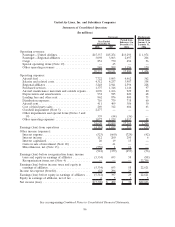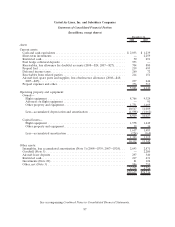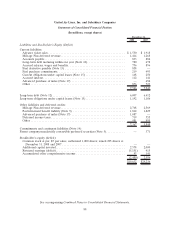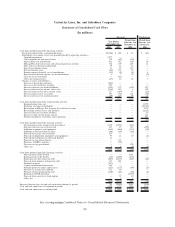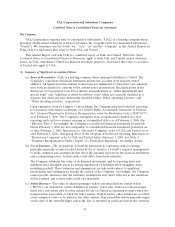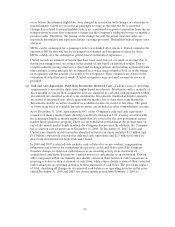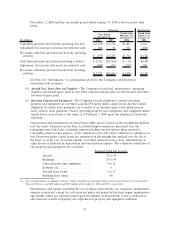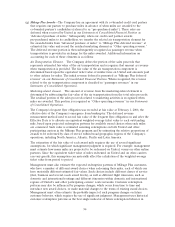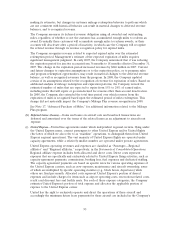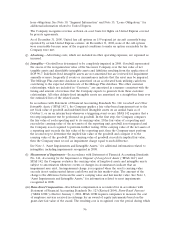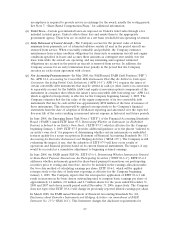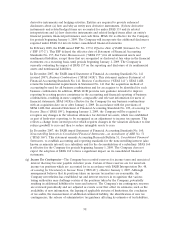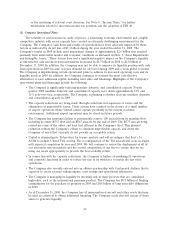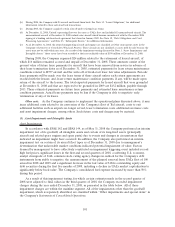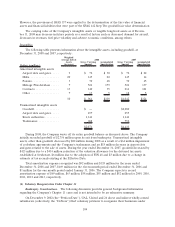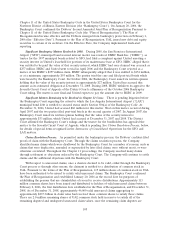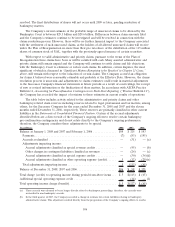United Airlines 2008 Annual Report Download - page 96
Download and view the complete annual report
Please find page 96 of the 2008 United Airlines annual report below. You can navigate through the pages in the report by either clicking on the pages listed below, or by using the keyword search tool below to find specific information within the annual report.lease obligations. See Note 10, “Segment Information” and Note 15, “Lease Obligations,” for
additional information related to United Express.
The Company recognizes revenue as flown on a net basis for flights on United Express covered
by prorate agreements.
As of December 31, 2008, United has call options on 159 regional jet aircraft currently being
operated by certain United Express carriers. At December 31, 2008, none of the call options
were exercisable because none of the required conditions to make an option exercisable by the
Company were met.
(j) Advertising—Advertising costs, which are included in other operating expenses, are expensed as
incurred.
(k) Intangibles—Goodwill was determined to be completely impaired in 2008. Goodwill represented
the excess of the reorganization value of the Successor Company over the fair value of net
tangible assets and identifiable intangible assets and liabilities resulting from the application of
SOP 90-7. Indefinite-lived intangible assets are not amortized but are reviewed for impairment
annually or more frequently if events or circumstances indicate that the asset may be impaired.
The Mileage Plus customer database is amortized on an accelerated basis utilizing cash flows
correlating to the expected attrition rate of the Mileage Plus database. The other customer
relationships, which are included in “Contracts,” are amortized in a manner consistent with the
timing and amount of revenues that the Company expects to generate from these customer
relationships. All other definite-lived intangible assets are amortized on a straight-line basis over
the estimated lives of the related assets.
In accordance with Statement of Financial Accounting Standards No. 142, Goodwill and Other
Intangible Assets (“SFAS 142”), the Company applies a fair value-based impairment test to the
net book value of goodwill and indefinite-lived intangible assets on an annual basis as of
October 1, or on an interim basis whenever a triggering event occurs. SFAS 142 requires that a
two-step impairment test be performed on goodwill. In the first step, the Company compares
the fair value of each reporting unit to its carrying value. If the fair value of a reporting unit
exceeds the carrying value of the net assets of the reporting unit, goodwill is not impaired and
the Company is not required to perform further testing. If the carrying value of the net assets of
a reporting unit exceeds the fair value of the reporting unit, then the Company must perform
the second step to determine the implied fair value of the goodwill and compare it to the
carrying value of the goodwill. If the carrying value of goodwill exceeds its implied fair value,
then the Company must record an impairment charge equal to such difference.
See Note 3, “Asset Impairments and Intangible Assets,” for additional information related to
intangibles, including impairments recognized in 2008.
(l) Measurement of Impairments—In accordance with Statement of Financial Accounting Standards
No. 144, Accounting for the Impairment or Disposal of Long-Lived Assets (“SFAS 144”) and
SFAS 142, the Company evaluates the carrying value of long-lived assets and intangible assets
subject to amortization whenever events or changes in circumstances indicate that an
impairment may exist. An impairment charge is recognized when the asset’s carrying value
exceeds its net undiscounted future cash flows and its fair market value. The amount of the
charge is the difference between the asset’s carrying value and fair market value. See Note 3,
“Asset Impairments and Intangible Assets,” for information related to asset impairments
recognized in 2008.
(m) Share-Based Compensation—Stock-based compensation is accounted for in accordance with
Statement of Financial Accounting Standards No. 123 (Revised 2004), Share-Based Payment
(“SFAS 123R”) effective January 1, 2006. SFAS 123R requires companies to measure the cost
of employee services received in exchange for an award of equity instruments based on the
grant-date fair value of the award. The resulting cost is recognized over the period during which
96


